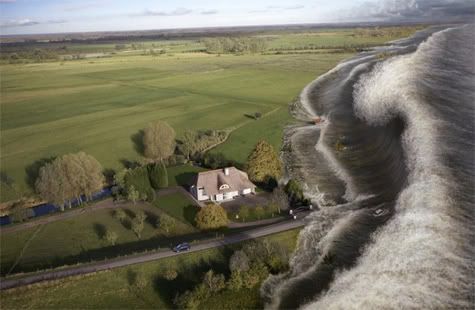
It's easy to think that sea-level rise is some remote and distant threat only faced by far away people who live in places like the Tuvalu Islands in the South Pacific which is having to evacuate to New Zealand as tidal floods increasingly cover their crops in seawater.
But right in the Bay Area, the Sacramento Delta has just joined those low-lying coastal regions that are the early victims of sea level rise. It's a typical suburban American area with some great salmon fishing and home to one of the stars of the UC system, CalDavis, renowned for its environmental study programs.
A CalDavis Public Policy Institute of California study has found that it will become increasingly beyond the ability of California taxpayers to keep shoring up levies to save parts of it next time it floods, and that these areas should just be abandoned.
While conceding that this is a very difficult and controversial conclusion for property owners who have been helped previously, study spokesman Professor Jay Lund says "I don't see any way they are not going to be losers, so the state policy should be that we all quit losing." Land owners would lose their property under the plan.
When a delta levee collapsed in 2004, the State and the Federal government spent a combined $75 million to repair land worth only $22 million. Richard Howitt, a UC Davis economist who helped put together the study felt that this was an irresponsible use of taxpayer money:
"We wanted to put a lot of work into what really amounts to a triage list - and say which islands, if they collapse, we say, "Sorry about that" but you don't repair them or pump them. You adjust to a new ecology." The participants making this tough collective decision were from diverse disciplines: civil engineering, climate science, economics, hydrology and biology. They established the boundary between the areas that should be saved and the places that would be left to go under.
Triage decisions like this one are already being practiced by other coastal low-lying coastal regions facing rising sea levels and costly climate change defenses. Seaside resorts on the coast of the UK are made an almost identical cost/benefit analysis. The whole town moved.
The financial issue is coming to the fore. Who will pay? Who should pay relocation costs? The Brazilian town of Atafono has been swallowed by the ocean. In Alaska, Kivalina is filing a lawsuit against oil companies for redress. The Sundurbans were already a lost cause in 2003, but little financial assistance has been forthcoming.
Ten percent of the world's population (600 million people) live in coastal areas that are less than 33 feet above sea level. These people are being being bandoned by their insurers, even when they live in the nice upscale coastal suburbs in America, from Florida and the Louisiana Gulf, and up to New York.
Furthermore, these direct climate change costs are in addition to the heavy costs we already collectively bear, as nation, of the damage caused by natural disasters like hurricanes and floods.
Disasters have increased four-fold in the last two decades, as worldwide temperature averages have increased.
Artwork by Dutch Artist Jaap Vliegenthart
From MIT Tech Review


